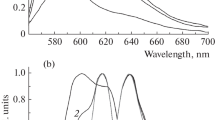Summary
-
1)
The development of colonies originating from staphylococci surviving the influence of high and medium concentrations of penicillin, experiences a delay and the variation of their growth-rate increases as compared with untreated bacteria. Critical concentrations of penicillin have a brief growth-stimulating effect.
-
2)
This delay in the development of colonies is connected with structural changes effected by penicillin. As the duration of the contact is longer and the concentrations higher, the changes become more radical.
-
3)
The first degree of involution is thought to be an intermediary form; next the ‘large body’; the more drastically transformed structures are supposed to be desintegration products of the large bodies.
-
4)
WithProtens mirabilis, E. coli, Streptococcus andH. influenzae also, organisms surviving the action of lethal concentrations of penicillin were found. The structural changes in these organisms are, if comparable at all, less frequent and mostly less radical than those found inStaphylococcus.
Similar content being viewed by others

References
Carrère, L. andRoux, J. 1954. C. R. Soc. Biol.148, 2050.
Chain, E. andDuthie, E. S. 1945. Lancet1, 652.
Dienes, L. 1947. Proc. Soc. Exp. Biol. and Med.64, 167.
Dienes, L. 1948. Proc. Soc. Exp. Biol. and Med.68, 589.
Dienes, L. 1949. J. Bact.57, 529.
Dienes, L. 1953. Proc. Soc. Exp. Biol. and Med.83, 579.
Eagle, H. andMusselman, A. D. 1949. J. Bact.58, 475.
Florey, H. W. et al. 1949. Antibiotics. Oxford Medical Publ.,1774 p.
Gardner, A. D. 1940. Nature146, 837.
Grasset, E. andBonifas, V. 1955. Ann. Inst. Pasteur88, 651.
Ingram, G. I. C. 1951. J. gen. Microbiol.5, 22.
Parker, R. F. 1953. J. Bact.66, 60.
von Prittwitz, J. 1953. Naturwissenschaften40, 590.
Pulvertaft, R. J. V. 1953. J. Path. Bact.65, 175.
Schönfeld, J. K. 1955. Antonie van Leeuwenhoek21, 316.
Sharp, J. T. 1954. Proc. Soc. Exp. Biol. and Med.87, 94.
Tulasne, R. 1948. C.R. Soc. Biol.142, 237.
Tulasne, R. 1950. C.R. Soc. Biol.144, 1200.
Author information
Authors and Affiliations
Additional information
Working with a grant of the foundation, “De Drie Lichten”.
Rights and permissions
About this article
Cite this article
Schönfeld, J.K., Oostijen-Klok, B. & Peuchen-Drost, N. Some data on the character of staphylococci surviving the action of penicillin. Antonie van Leeuwenhoek 22, 307–320 (1956). https://doi.org/10.1007/BF02538343
Received:
Issue Date:
DOI: https://doi.org/10.1007/BF02538343


